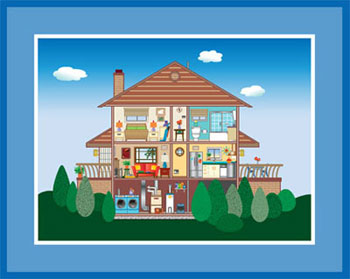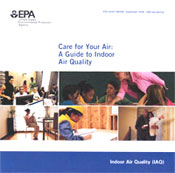Take the Care for Your Air Tour
|
Get a quick glimpse of some of the most important ways to
protect the air in your home by touring the Indoor Air Quality
(IAQ) House. Room-by-room, you'll learn about the key pollutants
and how to address them.
(SWF Movie, 317KB)
If you don't want to take the tour, read our text version Some features of this site require the latest version of Adobe Flash
Player
|
Text Version
Contents
Living Room
A living room is usually a well-used area of a home and may harbor indoor pollutants. It is important to ventilate properly, keep secondhand smoke outside of the house, and vacuum and dust regularly.
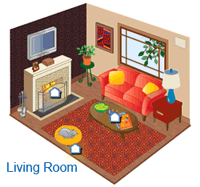 |
Pet Dander and Hair Pets can trigger allergy and asthma attacks due to dander and hair. Keep them out of the sleeping areas, and away from upholstered furniture, carpets, and stuffed toys. Vacuum and clean carpets, rugs, and furniture often. Learn more Secondhand Smoke Secondhand smoke from cigarettes, cigars, and other tobacco products can trigger asthma and other respiratory illnesses especially in children. To help protect children from secondhand smoke, do not smoke or allow others to smoke inside your home or car. Learn more Carbon Monoxide Fireplaces and leaking chimneys are sources of carbon monoxide. Ventilate rooms that have fireplaces, make certain the flue damper is operational and fully open when in use, and ensure the chimney is properly sealed. Learn more |
Bathroom
A bathroom is often the dampest area of a home. It is important to ventilate a bathroom during use and dry damp surfaces.
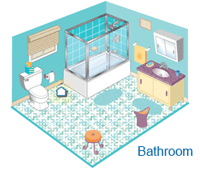 |
Mold Bathrooms are a common source of mold. Humidity from showers can cause moisture problems, which will lead to mold growth. Mold can cause allergic reactions, asthma, and other respiratory ailments. Installing and using a ventilation fan will help to control moisture and inhibit mold growth. Learn more |
Bedroom
A bedroom often contains materials that collect dust. It is important to clean bedding and other fabrics, and vacuum regularly.
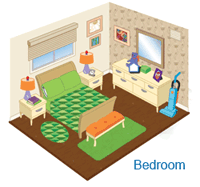 |
Dust Dust mites can trigger allergy and asthma attacks. Dust mites are everywhere especially on pillows, blankets, carpets, upholstered furniture, and stuffed toys Dust and vacuum your home regularly, wash bedding, and use allergen-proof mattress and pillow covers. Learn more |
Kitchen
A Kitchen has appliances that may leak gases, and often contain chemicals for cleaning or removing pests. It is important to properly maintain and ventilate appliances, and safely store chemicals.
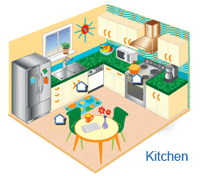 |
Pesticides Pesticides, used to rid homes of rodents, termites, insects, and other pests, can irritate the eyes, nose, and throat; damage the central nervous system and kidneys; and increase the risk of cancer. Don’t leave food out, and if you must use pesticides, ventilate during and after use and follow directions to limit exposure. Use non-chemical methods of pest control when possible. Learn more Volatile Organic Compounds (VOCs) Common household cleaners, often placed under the kitchen sink, release Volatile Organic Compounds (VOCs), when used and stored. Store household products that contain chemicals according to manufacturers’ instructions and keep all products away from children. Consider purchasing cleaners without VOCs. Learn more Carbon Monoxide To help prevent carbon monoxide exposure, make sure appliances such as gas stoves vent to the outside whenever possible and that all appliances are properly installed, used, and maintained. Learn more |
Basement
A basement is a source of air leaks and moisture, and often contains various chemicals. It is important to ventilate, seal cracks, and properly store all chemicals.
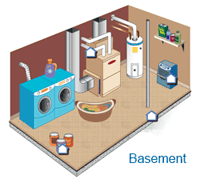 |
Carbon Monoxide Combustion heating and cooling appliances such as heating, ventilation, and air conditioning units, gasoline-powered heaters, and other appliances are sources of carbon monoxide. Properly install, use, and maintain fuel-burning appliances. Install carbon monoxide detectors in living spaces. Learn more Volatile Organic Compounds (VOCs) Paints, resins, paint thinners, and chemicals, and other products, will still release Volatile Organic Compounds (VOCs) even while stored properly. Make sure there is plenty of ventilation when painting, remodeling, or using other products that may release VOCs. Consider purchasing low and no VOC products. Learn more Mold Basements can be damp. Install a properly sized dehumidifier to help keep your basement at an appropriate humidity level and reduce the potential for mold. It is important to dry water-damaged areas and items within 24-48 hours to prevent mold growth. Learn more Radon Radon, a naturally occurring radioactive gas, is the second leading cause of lung cancer among non-smokers in the U.S. It enters a home through cracks and openings in floors and walls in contact with the ground. Learn more
|
![[logo] US EPA](https://webarchive.library.unt.edu/eot2008/20090510100049im_/http://www.epa.gov/epafiles/images/logo_epaseal.gif)
